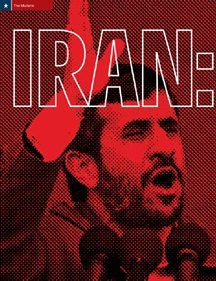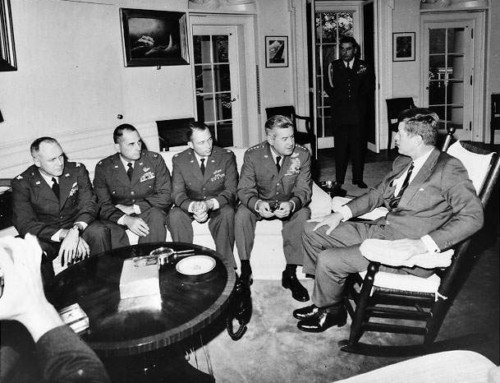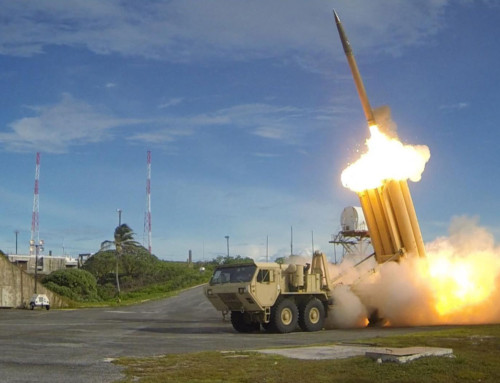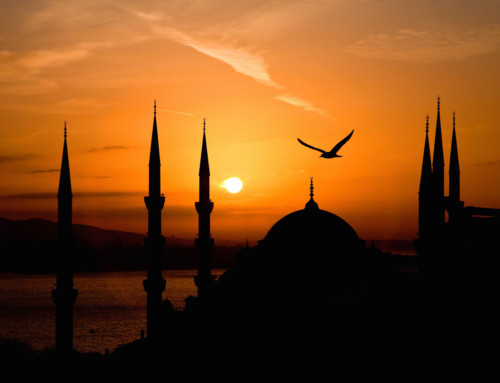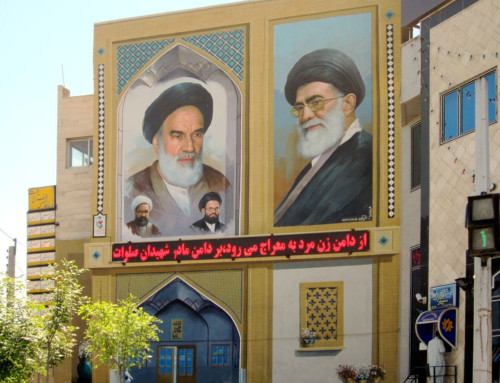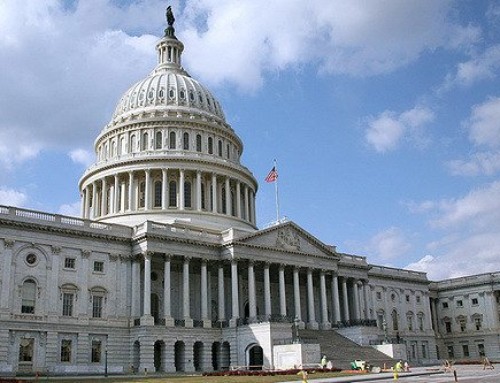Original article in Townhall Magazine (pdf)
Iranian President Mahmoud Ahmadinejad and his masters, the ruling mullahs of Iran, continue to threaten the United States and the rest of the West, as well as their own people. Who are they, and how can they be stopped?
During the decade of the 150s B.C., Cato the Elder invariably brought a fresh fig to the Senate as a prop to illustrate the fact that it could easily arrive via the short voyage from Carthage, Rome’s mortal enemy. He would end each address in the Senate with Carthago delenda est (“Carthage must be destroyed”).
During the decade of the 1930s, Winston Churchill repeatedly warned his countrymen of the gathering Nazi threat by reminding them that history contains many examples of people who waited too long to confront a ruthless foe. In so doing, Churchill warned, they invariably forfeited an earlier opportunity to easily defeat their enemy. Instead, they found that, because they waited too long, they were left with only two options—surrender and be enslaved or fight and perish.
Iran has been committing acts of war upon the United States for nearly 30 years—acts of war we’ve strangely chosen to ignore. But now, with the Iranians very close to acquiring a nuclear arsenal and testing the delivery mechanisms for electromagnetic pulse (EMP) weapons, where the detonation of a single EMP weapon could wipe out America’s entire vital communications infrastructure, the inevitable question arises: Are there any “Catos” or “Churchills” left within the Bush inner circle?
IRAN’S TOP TERRORIST
Last February, Imad Mugniyeh was blown into globs of protoplasm on a well-to-do Damascus street, in close proximity to the Syrian intelligence offices. His career perfectly mirrored the ascendancy of Tehran as the world’s headquarters for Muslim terrorism.
During the Clinton administration, Robert Baer was very likely the only American intelligence offi cer able to penetrate the Islamic terror networks. In his landmark book, See No Evil: The True Story of a Ground Soldier in the CIA’s War on Terrorism, he exposes the fact that Iran has provided training, finances, logistics and diplomatic cover for militarized Muslims who have attacked the United States continuously from 1979 to the present.
Baer and others such as Ken Timmerman, author of Countdown to Crisis: The Coming Nuclear Showdown With Iran, have exposed that the ’83 bombings of our embassy and Marine barracks in Beirut, the ’96 Khobar Towers bombing in Saudi Arabia and the Sept. 11 attacks all have very identifiable Iranian fingerprints on them. Moreover, Mugniyeh was Iran’s point man. For 25 years, he was the regime’s perennial liaison to the various terrorist teams that carried out the most spectacular attacks against Israel and the United States. A Lebanese Shiite, Mugniyeh provided the Iranians with the perfect operative who had both an unquenchable thirst for killing the infidel and complete plausible deniability.
THE IRANIAN REGIME AND 9/11
Timmerman’s “Countdown to Crisis” provides a vivid snapshot of how Iran participates in and facilitates global terrorism. Two months before 9/11, on July 26, 2001, a security offi cial from Iran’s Ministry of Information and Security (MOIS) headquarters in Tehran walked into a backwater U.S. embassy in Baku, Azerbaijan. Hamid Reza Zakeri told the receptionist that he wanted to speak to the CIA and that he had information about an impending attack on the United States. Two days later, “CIA George” interviewed Zakeri, thought him an imposter and sent him on his way. No information from the lution. “Baku walk-in” was even passed up the chain of command.
Timmerman laboriously vetted Zakeri, and with help from men like Baer, compared his reports with those from other defectors and with sources inside Iran. The CIA, FBI and two separate European intelligence agencies also confirmed Zakeri’s employment at Iran’s MOIS and his job in a recently created intelligence service within the Office of the Supreme Leader. His job was to coordinate the physical security for the regime’s most senior leaders and their important foreign visitors.
Zakeri said that, over the first six months of 2001, he had escorted al Qaeda’s No. 2 man, Ayman al Zawahri, Osama bin Laden’s eldest son, Saad, and their entourages to several major “planning sessions” in and around Tehran. There the men of al Qaeda met with the regime’s most senior leaders, all five mullahs of the Leadership Council, the Supreme Leader Ali Khamenei and former Iranian President Akbar Rafsanjani.
On May 4, 2001, according to Zakeri, at a meeting where Saad bin Laden was in attendance, the specifics of the 9/11 attacks were presented and the Iranian regime decided to provide the operational assistance. Zakeri even produced for Timmerman a memo from the Iranian leadership laying out guidelines for joint operations with al Qaeda. It stressed that the Iranian regime should limit its relations with al Qaeda to just two people—al Zawahri and Imad Mugniyeh.
The 9/11 Commission Report makes a few tepid allusions (Pages 240-241) to the “8 to 10 al Qaeda muscle operatives” fl ying into and out of Iran in 2000 and 2001 and to a “senior Hezbollah operative” accompanying them. In Countdown, Timmerman reveals that the “senior Hezbollah operative” was, in fact, Imad Mugniyeh, a piece of information he learned from sources on the 9/11 Commission itself. Timmerman goes on to describe an Iranian regime that, at its most senior level, was involved in the planning of the 9/11 attacks and provided the terrorists with safe haven, intelligence assistance, secure diplomatic communications, safe travel with falsified passports, escorts, training in airline hijacking, and money. With the sole exception of the Chicago Tribune’s John Crewdson and Phillip Shenon of the New York Times, no reporters from major news organizations have ever picked up on these explosive revelations. Nor has the CIA followed up—at least in public—despite an admonition from the 9/11 Commission that “further investigation” of Iran’s role in 9/11 was required
WHO ARE THE RULING MULLAHS AND THEIR SURROGATES?
During the 1970s, while the Shah was a close American ally in the Cold War, the Ayatollah Khomeini operated out of Iraq and then out of France. While in France, he distributed vast numbers of sermons to mosques and receptive congregations across Iran and other Shiite enclaves throughout the Islamic world. As a result, it became common knowledge in the Middle East that Khomeini had a five-step plan for the conquest of the West:
- the overthrow of the Shah and the establishment of a theocracy in Iran;
- the creation of new theocracies in the Middle East by revolution or war;
- the destruction of Israel;
- the Islamic takeover of Europe; and
- the destruction of the Great Satan (a.k.a. the United States).
Carter’s ambassador to the United Nations, Andrew Young, called Khomeini a “saint.” When the government of the Shah of Iran fell in February of 1979, the Carter administration, in partnership with a pliant and gullible press, was largely successful in convincing the western public that the Iranians overthrew the Shah because of his repressive rule. Yet the new Khomeini regime loudly proclaimed, for anyone who bothered to listen, that Iran had become too modern, too tolerant, and they rounded up and murdered about 3,500 senior officers from the shah’s armed forces during the fi rst week of the revolution in February 1979. Eight months after the regime took power, student mobs stormed and occupied the U.S. embassy.
As Americans watched the hostage drama on television night after night, no one could know then that what we were seeing was only a preview of what the Iranian mob meant by “Death to America.” What we now know is that, true to his plan to destroy Israel, Khomeini quickly partnered with Syria’s President Assad to create one of the world’s most dangerous terrorist organizations: Hezbollah. This was a truly ominous development, because the governments of Syria and Iran, one Sunni the other Shiite, became partners. They became what Michael Ledeen calls the new “Terror Masters.”
In the ensuing weeks after seizing power, Khomeini also appointed a hardened young resistance fighter named Mohsen Rezai to form a new intelligence service, which became the Republican Guard or Pasdaran. The Supreme Leader tasked Rezai with creating a secret police force that was separate from and not answerable to the provisional new government. Khomeini also immediately instituted the practice of public hanging and stoning. The Islamic world’s first terrorist state, like all totalitarian regimes, would first rain terror down on those inside its own borders who did not wish to conform. The incarceration, torture and murder of Iranian prisoners of conscience and non-conformists continue to be massive and widespread today.
At Khomeini’s death, on June 3, 1989, a minor cleric, Ali Khamenei was elevated to Supreme Leader, and the wealthiest man in Iran, Akbar Rafsanjani, soon became president. Due to his prestige as both a cleric and an internationally known businessman, Rafsanjani effortlessly played a double game. He convinced the easily duped western media and western governments that he was a moderate and a reformer. At the same time, he sent teams of hit men out of the country to assassinate Iranian expatriate opposition leaders. In July, Rafsanjani authorized the murder of Kurdish leader Abdelrahman Qassemlou in Vienna after pretending to negotiate a truce with him and his Kurdish Democratic Party of Iran. In addition to sponsoring many other high value “hits” in Europe, he personally signed off on major attacks on the United States, such as the Khobar Towers bombing in Saudi Arabia as well as 9/11. And he is still one of the driving forces behind Iran’s mad dash to acquire nuclear weapons.
MAHMOUD GAINS POWER
In June 2005, in a sham election, Mahmoud Ahmadinejad was elevated to the presidency of Iran. His story is similar to that of a “made man” in a kind of rogue-state crime family, an Islamofascist “capo,” granted his position as a reward for long service in the conduct of risky, lethal operations necessary to running the family’s criminal enterprise.
On Monday, June 27, the day the runoff results were final, the London-based Iranian news agency, Iran Focus, “outed” Ahmadinejad as one of the ringleaders who took over the U.S. embassy in November 1979. As the story began traveling around the globe at the speed of light, the Iranian government quickly denied that Ahmadinejad was involved. Subsequently, a number of the American hostages have identified Ahmadinejad as one their captors. A British journalist, John Simpson, has gone on the record as remembering him in a leadership role on the grounds of the embassy compound.
A simple web search combining the name Ahmadinejad with U.S. hostages produces vast numbers of stories from Iran’s own news agency that describe how he first came to the attention of the ruling Mullahs. Numerous reports record that shortly after the fall of the Shah, while attending Elm-O Sanat University in Tehran, he became one of the founders and key leaders of a student association, Office for Strengthening Unity (OSU), that was dedicated to worldwide Islamic revolution.
In assuming power, Khomeini immediately closed the universities for three years while tasking the OSU with purging dissident lecturers and students, many of whom were arrested and executed. Iran Focus reports that the OSU also played a central role in the obviously state-sanctioned embassy takeover. During the 444 days that the hostages were held, Ahmadinejad along with other OSU leaders met regularly with Khomeini himself.
In the early 1980s, Ahmadinejad moved to the Revolutionary Guards and earned notoriety as a ruthless interrogator, torturer and executioner in the infamous Evin Prison, where thousands of political prisoners were tortured and executed in the purges of the 1980s. By 1986, Ahmadinejad had become a senior officer in the Special Brigade of the Revolutionary Guard that was stationed in Ramazan Garrison near Kermanshah in western Iran. It was the headquarters for the “extra-territorial operations,” and he was the senior planner in a series of assassinations in the Middle East and Europe, which included the aforementioned killing of Iranian Kurdish leader Qassemlou.
In April 2003, he was elected mayor of Tehran, following a second stint at Elm-O Sanat University. While mayor of Tehran, he founded a new and even more fundamentalist political party of local politicians called the Developers of Islamic Iran. They partnered with his old cadre of thugs from the Revolutionary Guards and were able to conduct sham municipal elections in 2003 and win a majority in Iran’s rubberstamp parliament in 2004. Since assuming the presidency, Ahmadinejad has made it clear in numerous pronouncements that the regime is planning to accomplish Khomeini’s third objective—the destruction of Israel.
IRAN’S ENEMIES WITHIN
The chauvinistic Mullahs running Iran have done a spectacularly poor job of integrating the minorities that ring the periphery of the Persian heartland and make up half its total population of 70 million. In Graeme Wood’s article for the Atlantic, “Iran: A Minority,” he plots, by region, the numbers of riots, bombings, assassinations and kidnappings perpetrated by the ethnic minorities who are in revolt against the regime.
In the southeastern province of Iran’s Sunni Baluchistan, Ahmadinejad’s motorcade was attacked by a group of Baluchis called Jundullah (Soldiers of God). In the northwest, Sunni Kurdistan has produced the greatest numbers of attacks against the regime. A number of Kurdish paramilitary groups have been attacking Revolutionary Guards forces inside Iran and retreating to Iraq where they openly train and recruit. In the southwestern province of Khuzestan lives Iran’s Arab minority. It is in this region that all the oil is extracted yet few of the inhabitants participate in the largess. Radicalized Arab groups have been blowing up government offices there.
The Azeris to the north may represent as much as 25 percent of the Iranian population. And while they are Shiite and much better represented in Tehran, they speak their own language and their countrymen to their north in Azerbaijan are staunch American allies. If a widespread irredentist movement were to spring up in this region—particularly one backed by the West—this would be the Mullahs’ biggest nightmare.
If we consider the model employed in the invasion of Afghanistan, where the U.S.-led coalition partnered with the Afghani Northern Alliance, a similar strategy emerges. The West could aid in a revolution of the Iranian people, using insurrectionist forces positioned on Iran’s periphery that are armed and already engaged in violent revolution. Massive hatred of the regime by the Iranians would certainly swell the U.S.-backed revolutionaries.
MANY IRANIANS LEAVING ISLAM
So widespread is the hatred for the Mullahs that indigenous Iranians are secretly abandoning Islam and converting to Hinduism, Christianity and Buddhism, and they are doing so despite the fact that apostasy is a crime punishable by death. Web sites such as Islam Watch, Faith Freedom International and many others display photos and biographical posts from Iranian apostates.
Amil Imani is a pro-democracy Persian-American, who, on his site, Freedom of Iran, writes: “The Mullahs presently ruling Iran are faced with monumental threats. Internally, the great majority of the populace is against their misrule. Labor unions, teachers associations, student groups, religious and ethnic minorities, journalists and many others have suffered and continue to suffer inordinate hardship under the heavy-handed Mullahs and their front-men.”
Imani maintains that this is leading to a widespread awakening to the belief that Islam is an alien faith brutally imposed upon a much more ancient and advanced Persian culture. He contends: “My country, the present Iran, a cradle of civilization, the land of Cyrus the Great—the first author of the Human Rights Charter—was ravaged by the Muslim killers. The upstanding Iranian people who lived by the Great Zoroaster’s triad of Goodly Thoughts, Goodly Speech, and Goodly Deeds stood no chance against the Muslim beasts.”
In speaking to Imani at his home in the American Southwest, he gave me a fascinating piece of information. He said that, based on his sources in Iran, the ranks of the Republican Guards—those forces that the Mullahs will use to fight off an invasion and or a revolution—are now increasingly filled with non-Persians, Arabic and non- Farsi speakers from Iraq, Syria, Jordan, etc., jihadist troops that mirror the composition of bin Laden’s al Qaeda. If it is true that the Mullahs now need to employ foreigners to fight Iranian revolutionaries, they must be aware that they are presiding over a country where loyalty to the regime is collapsing.
THE REGIME’S CRIMES AGAINST HUMANITY
The human rights violations committed by the Shah are infinitesimal compared to those of the Mullahs. Amnesty International has charged Iran with having amassed the third-worst record in the world in terms of its summary executions and overall brutality visited upon its own people, many of them women and minors. The Mullahs have also put to death many high-profile people such as the female photographer, Zahra Kazemi, who came to Iran from Canada on a journalist visa. For the crime of photographing families gathered outside Tehran’s Evin Prison, families petitioning the government for news of their loved ones, she was herself imprisoned and died under torture.
Roya Teimouri is an Iranian-born American, an Islamic apostate and a modern-day heroine. In addition to running her own business in California, she works with Amnesty International and various Iranian expatriate organizations to expose the plight of Iranian individuals who are imprisoned and awaiting execution by the regime. Roya has been able to gain freedom for many of her compatriots but laments losing many more to the Mullahs’ executioners. “I speak out for my people who are in prison and for those who cannot speak because they have already lost their lives,” she told me.
Teimouri explains that Iran is unlike America where we are innocent until proven guilty. There you are just guilty. They capture people on the smallest of pretexts, then torture and execute them. “They want to kill us, because this is how they create fear,” she said, “and fear is how they control the country.”
NUCLEAR IRAN: A TERRORIST STATE ON STEROIDS
Iran is definitely moving ahead with Khomeini’s five-point plan for the domination of the West. Fear of resurgent militant Islam inexorably tightens its grip on Western European governments. A recent Wall Street Journal editorial, “London’s Terror Bank,” reported that the United States cut off all commerce with Iran’s Bank Saderat due to its transfer of $50 million to front groups of Hamas and Hezbollah. Yet, as testament to the fact that Western Europe is slipping into the Islamic world’s orbit, Britain, France, Germany and Greece are all allowing Bank Saderat branches and affiliates to operate openly in their capitals. Forbes magazine reports that, in 2006, when Israel invaded Lebanon, Hezbollah had 14,000 rockets. Today, they have 40,000 rockets that will no doubt rain down on Israel if it attacks Iran’s nuclear sites.
Should Iran successfully detonate a nuclear weapon, the Mullahs will become a terrorist state on steroids. Brigitte Gabriel, a Lebanese Christian, explains in her book, “Because They Hate,” Lebanon was once not just the lone Christian-majority country in the Middle East but it was also the only democracy in the Arab world. Today, it is dominated by extremist Muslims and is descending into chaos due to the terror tactics of Hezbollah and its backers, Syria and Iran.
This “Lebanon-ization” model is what most experts believe a nuclear-armed Iran will seek to impose everywhere in the Middle East. With utter impunity, it will finance and train more and more jihadist groups that will conduct terror operations aimed at, among many objectives, the interruption of the world’s oil supply, driving the price to $200 a barrel and higher. As the cost of fuel skyrockets, it will wreak havoc on major European and American industries. And through its jihadist proxies, Iran will attempt to destabilize more Middle East governments so that many new Hezbollah branches can be planted and grown, all of them aligned with Iran, the world’s headquarters for Islamic terror.
IRANIANS FOR AN ATTACK ON IRAN?
Just as there was no international outcry in 1999 when President Bill Clinton and the European heads of state authorized the bombing of Serbia in order to halt the supposed ethnic cleansing of Kosovo, and just as there was no outcry earlier this year, even from Middle Eastern capitals, when the Israelis took out the North Korean nuclear reactor in Syria, former United Nations Ambassador John Bolton is on the record saying that, if the United States takes out Iran’s nuclear sites, Arab leaders will be “pleased.” He adds that those leaders will express that view privately while issuing denunciations publicly.
Even some Iranians, such as Roya Teimouri, hope the United States will go beyond supporting the Iranian revolution and actually attack the regime and free her country. She tells me that Islam has produced such a high percentage of Muslims who have been brainwashed to hate Jews that, if Israel attacks Iran, it may actually thwart the revolution and push the chance for peace and reconciliation back centuries. Moreover, there is a large population of Iranian Jews inside and outside the country who still love Iran but who will suffer retribution.
On the evening of Sept. 11, 2001, an important event occurred that the western press completely missed. In contrast to the celebrations that were occurring throughout the Middle East that tragic evening, thousands of Persians flooded the streets of Iran and took part in a silent candlelight vigil, mourning the loss of American lives on 9/11. The Iranian police tried to stop the demonstration. But they couldn’t. There were too many mourners. “This took place because the people of Iran love Americans and they want to be free like Americans,” Teimouri told me.
Even though she has family and close friends in Iran whose lives would be endangered by an attack, Teimouri knows that they and a vast number of Iranians—young and old, Persian and minorities, students, peasants, Kurds, Baluchis, Azeris—are eager for the United States to attack.
“The U.S. must take out the head of the snake, the Republican Guards, the Mullahs, and the media,” Teimouri says. “I hear from the families of prisoners from all over Iran. We pray for the U.S. to attack this regime. We can’t wait to be free.”
NOTE: Published in Townhall Magazine

